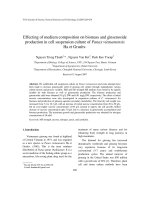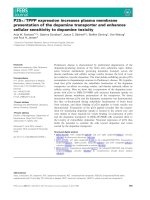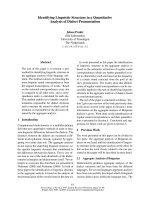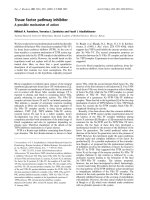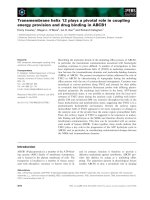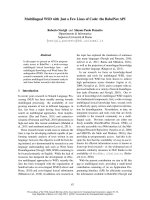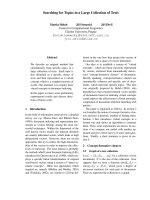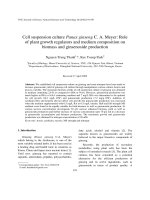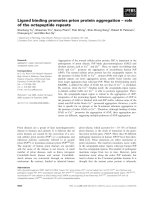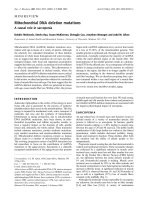Báo cáo " Cell suspension culture Panax ginseng C. A. Meyer: Role of plant growth regulators and medium composition on biomass and ginsenoside production " docx
Bạn đang xem bản rút gọn của tài liệu. Xem và tải ngay bản đầy đủ của tài liệu tại đây (106.88 KB, 6 trang )
VNU Journal of Science, Natural Sciences and Technology 26 (2010) 191-196
191
Cell suspension culture Panax ginseng C. A. Meyer: Role
of plant growth regulators and medium composition on
biomass and ginsenoside production
Nguyen Trung Thanh
1,
*, Kee Yoeup Paek
2
1
Faculty of Biology, Hanoi University of Science, VNU, 334 Nguyen Trai, Hanoi, Vietnam
2
Department of Horticulture, Chungbuk National University,
361-736
Cheongju, Korea
Received 17 April 2009
Abstract. We established cell suspension culture on ginseng and some attempts have been made to
increase ginsenoside yield of ginseng cell culture through manipulation various culture factors and
process variable. The maximum biomass yields of cell suspension culture of ginseng was obtained
in medium containing 2,4-D as compared to IBA or NAA. However, ginsenoside production was
much higher in IBA or NAA containing medium and 7 mg/L IBA was determined to be optimal
for cell growth (10.1 mg/L DW) and ginsenoside production (7.2 mg/g DW). Addition of
cytokinin (BA and kinetin) did not affect cell growth but ginsenoside production was increased
when the medium supplemented with 0.5 mg/L BA or 0.5 mg/L kinetin. Half and full strength MS
medium were found to be equally suitable for both biomass as well as ginsenoside production. At
various sucrose concentration investigated, 30 g/L sucrose enhanced biomass yield as well as
ginsenoside production and further increase of sucrose concentration upto 70 g/L led to a decrease
in ginsenoside accumulation and biomass production. The maximum growth and ginsenoside
production was obtained for nitrogen concentration of 30 mM.
Keywords: Auxin, cytokinin, sucrose, MS strength and nitrogen.
1. Introduction
∗
∗∗
∗
Ginseng (Panax ginseng C.A. Meyer)
which belong to the Araliaceae, is one of the
most variable oriental herbs. It has been used as
a healing drug and health tonic in countries as
Korea, China and Japan since ancient times [1].
Until now, ginseng has reported to contain
saponins, antioxidants, peptides, polysaccharides,
_______
∗
Corresponding author. Tel.: 84-4-38582178.
E-mail:
fatty acids, alcohol and vitamin [2]. The
saponins known as ginsenosides are widely
believed to the major bioactive compounds of
ginseng.
Recently, the production of secondary
metabolites using plant cells has been the
subject of extended research [3]. The plant cell
cultures has been considerd as a potential
alternative for the efficient production of
ginseng and its active ingradients, such as
ginsenoside in terms of product quality. A
N.T. Thanh, P.K. Yoeup / VNU Journal of Science, Natural Sciences and Technology 26 (2010) 191-196
192
number of reports of ginseng cell culture were
published time to time [4-6]. However, there is
still a need to the productivity of the tissue
culture process in order to be economically
competitive with field cultivation of ginseng. A
number of physical and chemical factors that
could influence secondary metabolite in plant
cell cultures have been found [2,7].
Optimization of the hormone concentration and
combination are often effective. For ginseng
cell growth, 2,4 D is most commomly used in
routine culture maintenance [6]. But use of this
suspected carcinogen often create health and
safety concerns. Alterations in the
environmental factors such as nutrient levels,
light, and temperature may also effective in
increasing productivity.
In this paper, we established cell suspension
culture of ginseng cell and some attempts have
been made to increase biomass and ginsenoside
yield of ginseng cell culture.
2. Materials and methods
Stock cell culture and culture condition
Stock suspension cells of P. ginseng were
maintained in MS medium. The cultural
conditions were done as described by [8].
Determination and analyses
Extraction and determination of ginsenoside
production were determined as reported
previously [9].
Experimental design and data analysis
All experiment were repeated three times
with 3 replicates. Data were subjected to
Duncan’s multiple range test using SAS
program (Version 6.12, SAS Institute Inc.,
Cary, USA).
3. Results and discussion
To understand the culture characteristics of
the suspended cells of ginseng in shake flask,
the effect of plant growth regulators (2,4-D or
IBA or NAA combination with BA or kinetin)
on cell growth, ginsenoside production by
cultured cells were focused on. The maximum
biomass yield of cell suspension culture of
ginseng was obtained in medium containing
2,4-D as compared to IBA or NAA. However,
ginsenoside production was much higher in
IBA or NAA containing medium (Table 1).
Considering these results, 7 mg/L IBA was
determined to be optimal for the cell growth
(10.1 g/L DW) and ginsenoside (7.29 mg/g DW
total ginsenoside) of ginseng suspension
culture. Addition of cytokinins (BA and
kinetin) did not affect cell growth but
ginsenoside productivity (particularly Rb
group) was increased when the medium
supplemented with 0.5 mg/L BA or 0.5 mg/L
kinetin (Table 2). These results obtained in this
present study is quite interesting because almost
all suspension culture of ginseng cells reported
until now were claimed to require 2,4-D which
is a potent herbicide and carcinogen and
therefore unsuitable for pharmaceutical and
food industries [10]. From this point of view,
our system is apparently favourable for the
process scale up for commercial ginsenoside
production by ginseng cells without addition of
the chemical 2,4-D.
N.T. Thanh, P.K. Yoeup / VNU Journal of Science, Natural Sciences and Technology 26 (2010) 191-196
193
Table 1. Effect of different auxin on cell growth and ginsenoside production
Ginsenoside (mg/g DW) Auxin Concentration
(mg/L)
Fresh wt.
(g/L)
Dry wt.
(g/L)
Rg Rb Total
2,4-D 1 328 a
z
11.9 a 1.81 2.35 4.16
1 144 d 7.5 d 2.16 3.05 5.21
3 170 c 8.8 cd 2.09 3.49 5.58
IBA 5 178 c 9.1 c 2.43 3.31 5.74
7 216 b 10.1 b 2.61 4.69 7.29
9 226 b 10.5 b 1.42 4.22 5.64
1 132 d 7.1 e 2.85 5.33 8.18
3 134 d 7.3 de 3.28 5.58 8.76
NAA 5 152 cd 7.8 d 2.61 4.83 7.44
7 164 c 7.6 cd 2.16 4.08 6.24
9 188 c 9.7 b 2.16 2.45 4.61
z
Mean separation by Duncan’s multiple range test at p ≤ 0.05
Table 2. Effect of different cytokinins (along with 7mg/L IBA) on cell growth and ginsenoside production
Ginsenoside (mg/g DW) Cytokinins Concentration
(mg/L)
Fresh wt.
(g/L)
Dry wt.
(g/L)
Rg Rb Total
0 192 b
z
10.1 b 1.88 2.78 4.66
0.1 230 a 11.2 ab 1.81 2.75 4.55
BA 0.5 252 a 11.5 a 1.75 5.33 7.08
1.0 243 a 11.1 ab 1.79 3.53 5.32
0.1 225 ab 11.1 ab 1.16 4.62 5.78
Kinetin 0.5 240 a 11.7 a 1.49 5.82 7.32
1.0 242 a 11.4 a 1.56 3.59 5.15
z
Mean separation by Duncan’s multiple range test at p ≤ 0.05
Table 3 shows the effects of different
strength of MS medium on biomass and
ginsenoside production. Half and full strength
MS medium were found to be equally suitable
for both biomass as well as ginsenoside
production. High salt strength (2.0) inhibited
cell growth ginsenoside production. Such a
phenomenon was also described in provious
cultures of ginseng adventitious roots [11].
Table 3. Effect of different sucrose concentration on cell growth and ginsenoside production
Ginsenoside (mg/g DW) Sucrose
concentr. (g/L)
Fresh wt.
(g/L)
Dry wt.
(g/L)
Rg Rb Total
10 27 d
z
2.9 d 0.32 0.66 0.98
30 180 a 10.8 a 2.17 4.39 6.56
50 98 b 8.4 b 1.07 2.25 3.32
70 52 c 5.7 c 0.09 1.58 1.67
z
Mean separation by Duncan’s multiple range test at p ≤ 0.05
N.T. Thanh, P.K. Yoeup / VNU Journal of Science, Natural Sciences and Technology 26 (2010) 191-196
194
At various sucrose concentrations
investigated, 30 g/L sucrose enhanced biomass
yield (180 g/L FW, and 10.8 g/L DW), and
ginsenoside production (total ginsenoside
production upto 6.56 mg/g DW). Further
increase of sucrose concentration upto 70 g/L
led to a decrease in ginsenoside accumulation
and biomass production (Table 4). On the
contrary of our results, several authors
suggested that a relatively high sucrose level
was benificial to secondary metabolite synthesis
[12]. For example, Weselake et al. [13] reported
that the triacylglycerol content of the cells of oil
seed rape could be increase about 8-fold on a
fresh weight basis when sucrose concentration
in the growth medium was raise from 2 to 22%
(w/v). Choi et al. (1994a, b) found that the
optimal concentration of sucrose for cell growth
was between 30 and 50 g/L and upto 70 g/L
sucrose inhibited cell growth, while the
ginsenoside content showed a steady increase
with sucrose concentration of upto 60 g/L.
Based on our results it can be concluded that
high sucrose level and secondary metablite
production is not a general phenomenon and
depends on plant species.
Table 4. Effect of different strength of MS medium on cell growth and ginsenoside production
Ginsenoside (mg/g DW) Sucrose
concentr. (g/L)
Fresh wt.
(g/L)
Dry wt.
(g/L)
Rg Rb Total
10 225 a
z
9.9 a 1.45 4.88 6.33
30 185 b 10.3 a 2.27 4.45 6.73
50 153 c 9.4 a 0.98 3.57 4.55
70 98 d 6.8 b 0.46 3.45 3.91
z
Mean separation by Duncan’s multiple range test at p ≤ 0.05
The effect of the initial nitrogen
concentration in the medium for cell growth
and metabolite production was studied in P.
ginseng cell cultures. The initial nitrogen level
was adjusted to 30, 60, 90 and 120 mM. The
kinetics of growth (based on dry weight) in
various cultures is shown in (Table 5). It is
apparent that growth was inhibited at a high
initial N concentration. The highest dry weight
reached 11.6 g/L at an initial nitrogen
concentration of 30 mM. The highest
ginsenoside production was (7.46 mg/g DW) at
initial medium nitrogen concentration of 30
mM after 25 days of culture.
Table 5. Effect of different nitrogen concentration on cell growth and ginsenoside production
nitrogen
concent.(mM)
Fresh wt.
(g/L)
Dry wt.
(g/L)
Ginsenoside (mg/g DW)
Rg Rb Total
30 206 a
z
11.6 a 2.85 4.62 7.47
60 182 b 10.8 a 2.17 4.48 6.65
90 112 c 8.1 b 0.65 4.11 4.76
120 76 d 6.1 d 0.23 4.32 4.56
z
Mean separation by Duncan’s multiple range test at p ≤ 0.05
N.T. Thanh, P.K. Yoeup / VNU Journal of Science, Natural Sciences and Technology 26 (2010) 191-196
195
In cell cultures of P. quinquefolium, [13]
reported that the final dry cell weight was
relatively low with the low nitrogen
concentration. Maximum cell dry weight
obtained (15 g/L) at a total initial nitrogen
concentration of 40 mM and the cell growth
was inhibited at a high initial nitrogen
concentration of 80 mM. Similarly, the
accumulation of total saponin and
polysaccharide were also influenced by initial
nitrogen concentration in the medium. The
maximum production of ginseng saponin and
polysaccharide obtained (1.5 g/L and 2.19 g/L)
at the initial nitrogen concentration of 40
mM.[14]. In the simultaneous production of
ginseng saponin and polysaccharide by
suspension cultures of P. ginseng, [15] reported
that production of ginseng saponin was related
with the total nitrogen concentration. The result
suggested that a low nitrogen concentration was
beneficial for the stimulation of total saponin
production.
References
[1] Tang W., G. Eisenbrand. 1992. Panax ginseng
C.A. Meyer, Chinese drugs of plant origin.
Springer-Verlag, Berlin, pp 710-737.
[2] Huang K.C., 1993. The pharmacology of
Chinense herbs. CRC press, Boca Raton, FL., pp
21-45.
[3] Bourgaud F., A. Gravot, S. Milesi and E.
Gontier. 2001. Production of secondary
metabolites: a historical perspective. Plant Sci.,
161: 839-851.
[4] Choi K.T., C.H. Lee, I.O. Ahn, J.H. Lee and J.C.
Park. 1994a. Characteristics of the growth and
ginsenosides in the suspension culture cells of
Korean ginseng (P. ginseng C.A. Meyer). In
W.G. Bailey, C. Whitehead, J.T.A. Proctor, J.T.
Kyle. (eds), Proce Int Ginseng Con., Vancouver,
pp. 259-268.
[5] Hibino K. and K. Ushiyama. 1999. Commercial
production of ginseng by plant tissue culture
technology. In: T.J. Fun, G. Singh, W.R. Curtis
(Eds.), Plant Cell and Tissue Culture for the
Production of Food Ingredients, Kluwer
Academic, Plenum publisher, pp. 215–224.
[6] Wu J.Y. and J.J. Zhong. 1999. Production of
ginseng and its bioactive components in plant
cell culture: current technological and applied
aspects. J. Biotech., 68: 89-99.
[7] Dornenburg H. and D. Knorr. 1995. Strategies
for the improvement of secondary metabolite
production in plant cell cultures. Enzymes
Microbiol. Technol., 17: 674-684.
[8] Thanh N.T., H.N. Murthy, K.W. Yu, E.J. Hahn
and K.Y. Paek. 2005a. Methyl jasmonate
elicitation enhanced synthesis of ginsenoside by
cell suspension cultures of P. ginseng in 5-l
balloon type bubble bioreactors. Appl Microbiol
Biotech., 67: 197-201.
[9] Thanh N.T., H.N. Murthy, K.W. Yu, E.J. Hahn
and K.Y. Paek. 2005b. High-density cultivation
of P. ginseng cells in balloon type bioreactors:
role of oxygen supply on biomass and
ginsenoside production. Genetics and Appl., 2:
7-13.
[10] Choi K.T., I.O. Ahn and J.C. Park. 1994b.
Production of ginseng saponin in tissue culture
of ginseng (P. ginseng C. A. Meyer). Russ. J.
Plant Physiol., 40: 784-788.
[11] Yu K.W. 2000. Production of the useful
metabolites through bioreactor culture of Korean
ginseng (Panax ginseng C. A. Meyer). Ph.D.
thesis, Chungbuk National University, Korea.
[12] Akalezi C.O., S. Liu, Q.S. Li, J.T. Yu and J.J.
Zhong. 1999. Combined effects of initial sucrose
concentration and inoculum size on cell growth
and ginseng production by suspension cultures
of P. ginseng. Pro Biochem., 34: 639-642.
[13] Weselake R.J., S.D. Byers, J.M. Davoren, A.
Laroche, D.M. Hodges, M.K. Pomeroy and T.L.
Furukawa-Stoffer. 1998. Triacylglycerol
biosynthesis and gene expression in microspore
derived cell suspension cultures of oilseed rape.
J. Exp. Bot., 49: 33-39.
[14] Zhong J.J. and S.J. Wang. 1998. Effects of
nitrogen source on the production of ginseng
saponin and polysaccharide by cell cultures of P.
quinquefolium. Pro. Biochem., 33: 671-675.
[15] Liu S. and J.J. Zhong. 1997. Simultaneous
production of ginseng saponin and
polysaccharide by suspension cultures of P.
ginseng - nitrogen effects. Enzyme and Microb.
Technol., 21. 518-524.
N.T. Thanh, P.K. Yoeup / VNU Journal of Science, Natural Sciences and Technology 26 (2010) 191-196
196
Nuôi cấy huyền phù tế bào Nhân sâm Panax ginseng C.A.
Meyer: Ảnh hưởng của các chất kích thích sinh trưởng
và một số thành phần trong môi trường ñến sinh khối
và sản phẩm ginsenoside
Nguyễn Trung Thành
1
, Kee Yoeup Paek
2
1
Khoa Sinh học, Trường Đại học Khoa học Tự nhiên, ĐHQGHN, 334 Nguyễn Trãi, Hà Nội, Việt Nam
2
Khoa Cây trồng, Trường Đại học Quốc gia Chungbuk, 361-736 Cheongju, Hàn Quốc
Tế bào Nhân sâm ñã ñược nuôi cấy trong môi trường lỏng MS ñể sản xuất sinh khối và sản phẩm
trao ñổi chất ginsenoside. Đối với auxin, sinh khối thu ñược lớn nhất ở 2,4-D so sánh với IBA và
NAA. Nhưng sản phẩm ginsenoside tích lũy cao ở IBA và NAA. Kết quả thu ñược là (7.2 mg/g trọng
lượng khô, tổng số ginsenoside) và sinh khối là 10.1 g/L trọng lượng khô ở nồng ñộ 7 mg/L IBA. Còn
ñối với cytokinin khi nồng ñộ tăng từ 0.1 ñến 1.0 mg/L (BA và kinetin) ñã không ảnh hưởng ñến sự
sinh trưởng của tế bào, nhưng tăng có ý nghĩa ñối với sản phẩm ginsenoside khi môi trường MS ñược
bổ sung 0.5 mg/L IBA hoặc NAA. Nồng ñộ môi trường MS với 50 hoặc 100% là thích hợp cho sự tích
lũy sinh khối tế bào và tổng hợp sản phẩm ginsenoside. Nồng ñộ ñường 30 g/L là tối ưu cho sự sinh
trưởng của tế bào và sự tổng hợp sản phẩm ginsenoside. Sinh khối tế bào và sản phẩm ginsenoside ñã
thu ñược lớn nhất ở nồng ñộ 30mM nitrogen.
Keywords: Auxin, cytokinin, sucrose, nồng ñộ môi trường MS.
